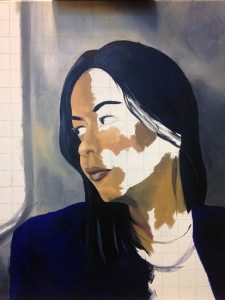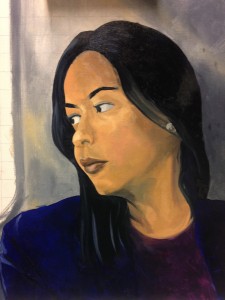|
|
 I had a day to myself when everything else was drying, and I put the Portrait of A back onto the easel. I’d already done the hair and jacket, but not completed them – they were on the canvas to do service in tone. If I hadn’t had that big black mass there, I wouldn’t have known how to paint the face to be surrounded by it. I had a day to myself when everything else was drying, and I put the Portrait of A back onto the easel. I’d already done the hair and jacket, but not completed them – they were on the canvas to do service in tone. If I hadn’t had that big black mass there, I wouldn’t have known how to paint the face to be surrounded by it.
The sketch is not perfect, even after using the grid to get it right. When I drew it, it was good, but some of it was in note form – a line might represent a turning point or a darker area. When I first started doing the background I could remember all of these things, and I had been staring at my photos a lot, and I knew the face. By the time I came to paint on the second day, I no longer had that information. I’d purged it to use the mental space for other paintings, mostly.
I started with the darker parts of the face for a couple of reasons. I wanted to get them in and the right shape because when you paint it tends to spread shapes a little, and when I added the skin tones I wanted to be working into the brows and shaping the eyes. This would mean they could get back to the right size with just a couple of passes. I also wanted to avoid painting details when the skin was already on, and wet. The brows are in a really awkward place, and the left eye – the one over to our right – is hard to bridge over to. Keeping a steady hand without support is hard. The hair was there and already dry, but I decided I still wanted the darks into the eyes and brows first.
 I recently went back and looked at how I painted my self-portrait, and found there was a paint that I no longer used much, which was pretty much perfect. Terre Cassel, or Van Dyke Brown, is a… well, it’s brown. It’s like boiled nicotine has been poured over the hopes and dreams of artists, and all of those artists are Dutch, or painting cows, or possibly peasant clothes. The mass colour is very slightly green grey, but mostly brown. It’s got a high tinting strength – you only need a little bit to ruin any colour at all – and it’s unpleasantly transparent. However, if used with dark colours it mixes beautifully with ultramarine to make something that looks like Indigo but it lightfast. It also stand up well on its own, and if you’re working on a brown passage, then it adds depth, and the tinting strength becomes a good thing. I recently went back and looked at how I painted my self-portrait, and found there was a paint that I no longer used much, which was pretty much perfect. Terre Cassel, or Van Dyke Brown, is a… well, it’s brown. It’s like boiled nicotine has been poured over the hopes and dreams of artists, and all of those artists are Dutch, or painting cows, or possibly peasant clothes. The mass colour is very slightly green grey, but mostly brown. It’s got a high tinting strength – you only need a little bit to ruin any colour at all – and it’s unpleasantly transparent. However, if used with dark colours it mixes beautifully with ultramarine to make something that looks like Indigo but it lightfast. It also stand up well on its own, and if you’re working on a brown passage, then it adds depth, and the tinting strength becomes a good thing.
I worked up several piles of colour and at first I went over in solid patches, getting the main areas right. This would form the face, and I didn’t want to blend at first. However, I pretty soon found I was blending those areas automatically, and it still looked good. This was a lot faster than my self-portrait, for the same effect. First you get good, then you get fast. Then you get fast and good. It’s worth me remembering that, because this is so much easier than it used to be, meaning I can concentrate on making it better.
 I have colour corrected the finished day’s work a little – the short working day in December means I was forced to finish some parts under sodium lighting. It was just about manageable, as I had mixed the colours already, but when I came to photograph it, A.G. looked far too yellow. I’ll need to darken down her skin a lot anyhow, while still leaving a youthful look on it, with a bit of blush. That was not a job for late evening with yellow-pink lights. Her skin is much closer to the tone of her lips than the tone of the background, and looked at in grey you could see the difference much more. However, the features are well formed and I now know how to do everything else. Her jacket, the window, her as-yet unpainted necklace, and a lot of other parts can be finished within a couple of days. I have colour corrected the finished day’s work a little – the short working day in December means I was forced to finish some parts under sodium lighting. It was just about manageable, as I had mixed the colours already, but when I came to photograph it, A.G. looked far too yellow. I’ll need to darken down her skin a lot anyhow, while still leaving a youthful look on it, with a bit of blush. That was not a job for late evening with yellow-pink lights. Her skin is much closer to the tone of her lips than the tone of the background, and looked at in grey you could see the difference much more. However, the features are well formed and I now know how to do everything else. Her jacket, the window, her as-yet unpainted necklace, and a lot of other parts can be finished within a couple of days.
Her earring is in, and I’ll put more hair over it once everything there is dry. It’s a good focal point, given that her face and her eyes are turned away. I’m wondering about the necklace, because it could go very badly wrong very easily, but there’s no point in being afraid of it. I just have to paint it until it’s done.
|